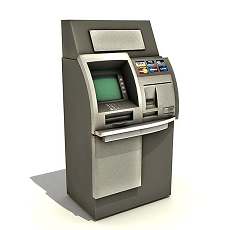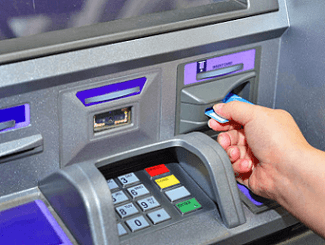ATM - Automated Teller Machine
ATM is the abbreviation of Automated Teller Machine. In old days, people used to stand in long queues in front of the banks to collect their salaries. Now, people visit the ATM nearest to their place and enjoy safe transactions. What is an ATMAn automated teller machine facilitates the transactions without involving a bank employee to deal with the customer's transaction. It has made transactions easy and hassle-free. Additionally, it has significantly reduced the bank workload. For any individual to complete transactions using an ATM, it is necessary to have a credit or debit card. Through these cards, any bank account holder can access their balance, or withdraw, deposit, or transfer cash from their account. The customers can perform these functions without visiting their bank branch. Hence successful transactions can be made without filling slips, forms and without standing in long queues. An ATM charges fees for cash withdrawal. This fee is charged by the bank, the ATM operator, or both. To avoid any fees for cash withdrawal, one should prefer using the ATM of the same bank in which they hold their account. ATMs are known by different names, such as cash machines and automated bank machines (ABM). 
How to use an ATM
History and Invention of the ATMThe idea of after the hours cash became popular in the 1960s. People started developing new machines to withdraw cash after bank hours and according to their convenience. A cash dispenser was used in the mid-1960s in Japan. A cash depositing machine known as Bankograph was developed in 1960. Luther George Simjian invented it. The era of ATM began with Barclays bank setting up its first ATM in its London branch in 1967. John Shepherd Barron is known to invent this ATM. It had a limit of GBP 10 at one time while withdrawing cash. Donald Wetzel was the first to develop an ATM in the U.S., set up a Chemical bank branch in New York in September 1969. The technology of Personal Identification Number (PIN) was developed in 1970. It was proposed by James Goodfellow. The invention of PIN accelerated the growth of the ATM. The network of banks such that the card of a bank could be used on the ATM of another bank was developed in the 1970s. Afterward, ATMs were adopted by many countries. Since ATMs have become irreplaceable and save time and effort for the customers. ATM CardsATM cards help the user to access their account through ATM. It is a plastic card that contains the customer account information in the form of a magnetic strip. An identification code is encrypted in the magnetic strip and contains all account details of the customer. This identification code is used for the authentication of the customer with the centralized bank. ATM cards are available in India's different forms, including Visa, Mastercard, Maestro, and RuPay cards. Functions of an ATMThe main functions of ATMs are cash withdrawal, cash deposit, and transfer of money from one account to another. These can be described as -
Types of ATMThe two types of ATMs are basic ATMs and complex ATMs. The function of a basic ATM is usually facilitating cash withdrawal along with an available balance statement. The complex ATM is responsible for multiple functions like displaying account information and providing transaction history and cash deposits. Some other types of ATMs are discussed below: Brown Label ATM: A Brown Label ATM is the one in which the service provider of the ATM owns the lease of the machine. Although the lease has been owned by the service provider, the network and connection with the bank are managed by the sponsor bank. Cash Dispenser: The ATMs that only dispense cash and are used for balance inquiry and mini statement. No other transactions are possible on these Green Label ATM: Green Label ATM facilitates agricultural transactions. Mobile ATM: Mobile ATM is the type of ATM which moves from one place to another, providing service to its customers. The covid-19 pandemic has led to the rise in the number of mobile ATMs in the cities. Off-site ATM: These machines are installed outside the premises of the bank. On-site ATM: These machines are installed within the premises of the bank. Orange Label ATM: These ATMs facilitate share transactions. Pink Label ATM: Pink label ATMs are specially made for women. White Label ATM: These ATMs are provided by companies that are financial but are in a non-banking domain. Worksite ATM: These ATMs are installed in the bank premises, but only bank employees can use these. Yellow Label ATM: These ATMs are used for online shopping. Design of an ATMATM is carefully designed by combining the individual components which are used for a particular function. The parts of the ATM are listed below -
The Evolution of ATMThe first ATM The era of ATM began with Barclays bank setting up its first ATM in its London branch; this was not until 1967. Drive-up ATMs The setup of drive-up ATM was first installed by Baton Rouge; this was not until 1980. The machine has been used for decades and was a successor to drive-up teller windows. Multiple option ATMs ATMs were then restricted to cash dispensing but were used for many purposes like stamps, etc. Eventually, all banks started adopting multiple service options through ATMs; this was not until 1988. Video ATMs The talking ATMs were developed to facilitate blind people to read. Now, they are no longer dependent on the braille keypads to complete their transactions.Video ATMs provided an intermediate solution in between the bank branch and the ATMs. A customer can video chat with the bank employees and proceed with their transactions. ATMs without cards ATMs without cards are the technology that proceeds the transactions without cards, simply using smartphones. People can access their accounts and complete transactions using one-time passwords (OTP) and their ATM pins. Germ Killing Touchscreens The screens of these ATMs have embedded silver ions. The embedded silver prevents the growth of bacteria, algae, and mold etc. Bitcoin ATMs These ATMs are part of a decentralized system of money transfer. They are not a part of the conventional banking system and still transfer money into the digital currency and vice versa. These machines cost a good sum of money but are still popular. Modern ATMAutomated Teller Machines have changed over the years. The reason for the changes ranges from safety concerns to providing convenience to the customers. Some changes that largely affected the ATMs are -
Advantages of ATM
Disadvantages of ATM
Impact of ATM on PeopleATM has revolutionized the way transactions work and is an invention of great importance. People worldwide can make safe bank transactions irrespective of the bank account they hold and the location of their branch of the bank. The invention of the ATM has saved the time and efforts of people and made transactions more convenient and accessible. Nowadays, people rely on ATMs to withdraw cash and many other functions, which would take hours when done through the banks. ATMs have given a fair chance for the people from poor sections of society to rise and control their accounts.ATMs are an all-time option to go with in case of emergencies. The revolutionary invention of ATMs has changed the way people do their transactions worldwide.
Next TopicDNA - Deoxyribonucleic Acid
|
 For Videos Join Our Youtube Channel: Join Now
For Videos Join Our Youtube Channel: Join Now
Feedback
- Send your Feedback to [email protected]
Help Others, Please Share










